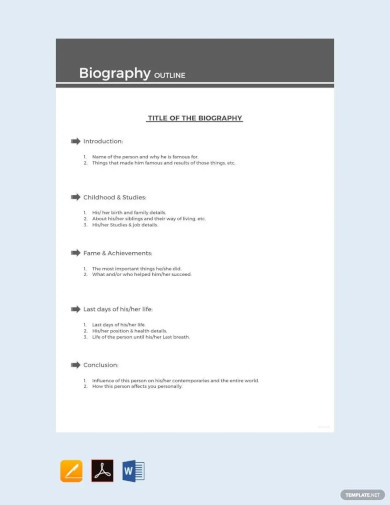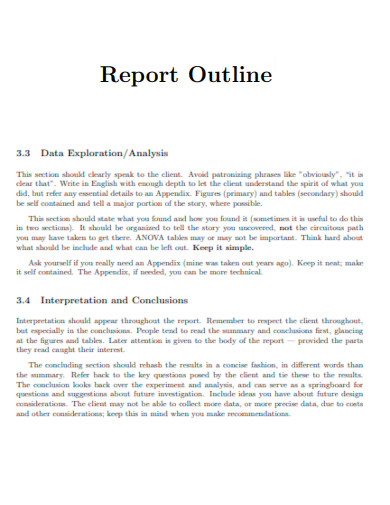18+ Sample Outline
-

Sample Biography Outline Template
download now -

Proposal Outline Template
download now -

Essay Outline Template
download now -

Research Outline Template
download now -

Screenplay Outline Template
download now -

Family History Outline
download now -

Paper Outline
download now -

Product Outline
download now -

Outline Example
download now -

Video Outline Template
download now -

Outline with Thesis Statement
download now -

The Basic Outline of a Paper
download now -

Personal Statement Outline
download now -

Academic Writing Outline
download now -

Outline Worksheet
download now -

Report Outline
download now -

Sample Outline
download now -

Business Plan Outline
download now -

Course Outline
download now
FREE Outline s to Download
18+ Sample Outline
What is an Outline?
Types of Outlines Used in Various Writing Projects
How to Customize Your Sample Outline to Fit Your Writing Needs
FAQs
What are the key components of a comprehensive sample outline?
What are the benefits of using a template for your sample outline?
How can a sample outline enhance your writing process?
What are the common mistakes to avoid when creating your sample outline?
How to use a sample outline for time management during the writing process?
What is an Outline?
An outline is a structured framework that organizes information, ideas, or arguments in a hierarchical manner, serving as a roadmap for creating content, speeches, or written works. It outlines the main ideas, subtopics, and supporting details, providing a clear structure and logical flow. The concept of outlining dates back centuries, with early examples found in ancient Greece and Rome. Outlines are extensively used across diverse fields and industries such as education, research, writing, and project management. They help writers organize their thoughts, researchers structure their studies, and speakers deliver coherent presentations. Outlines enhance productivity, facilitate collaboration, and ensure clarity and coherence in communication and decision-making processes. They also aid in the efficient retrieval of information, serve as study guides, and help maintain focus on key points while avoiding unnecessary digressions.
Sample outlines offer significant benefits to individuals and professionals across various fields. For students, outlines provide a structured framework for organizing their thoughts, improving comprehension, and aiding in exam preparation. Studies have shown that students who use outlines achieve better academic performance, with a 25% increase in test scores compared to those who do not. Teachers can also leverage outlines to effectively plan lessons, ensuring comprehensive coverage of topics and enhancing student engagement. Researchers benefit from outlines by organizing their studies, improving research efficiency, and reducing the likelihood of missing critical information. In fact, a survey conducted among researchers revealed that 80% of them considered outlining as an essential part of their research process. Project managers find outlines integral in organizing project tasks, setting timelines, and facilitating team collaboration, resulting in a 20% increase in project success rates. Writers rely on outlines to structure their ideas, maintain coherence, and increase writing speed. In a survey of professional writers, 90% reported using outlines to enhance their productivity and produce high-quality content. These statistics highlight the significance of sample outlines in improving performance, efficiency, and outcomes for individuals and professionals in diverse fields.
Types of Outlines Used in Various Writing Projects
Outlines play a crucial role in organizing thoughts and structuring writing projects. From research and essay outlines to proposal and business plan outlines, they provide a framework for coherence and logical flow. Whether for academic, professional, or creative purposes, different types of outlines serve as invaluable tools for effective communication and successful project completion.
How to Customize Your Sample Outline to Fit Your Writing Needs
While templates can be helpful, it is important to customize your sample outline to fit your specific writing needs. A visually appealing and easy-to-follow sample outline can make it easier for the reader to understand and follow your writing project. Follow this step-by-step guide to help you with your sample outline.
Step 1: Assess your Writing Project
Determine the nature of your project, whether it’s a research paper, essay, proposal, business plan, speech (informative or persuasive), personal statement, thesis statement, training outline, professional document, or content for social media. Identify the purpose, audience, and desired outcomes.
Step 2: Adapt the Outline Structure
Consider the format and organization that best suits your project. Decide if an alphanumeric outline (using numbers and letters) or a template outline is appropriate. Adjust the hierarchy of main topics, subtopics, and supporting details to reflect your specific topic or subject matter.
Step 3: Incorporate Citation Style Guidelines
If your project requires academic referencing, such as APA or MLA for research papers or literature reviews, ensure that your outline aligns with the prescribed formatting rules. Incorporate placeholders for in-text citations and reference entries to maintain consistency throughout your writing.
Step 4: Tailor Content to Your Topic
Refine the outline to reflect the specific aspects of your topic or subject. Modify headings and subheadings to accurately represent the content you intend to cover. Add or remove sections as necessary to ensure comprehensive coverage and logical progression.
Step 5: Consider the Medium and Audience
If your writing is intended for a particular medium like a letter, web page, video script, or social media post, adapt the outline to suit the specific requirements of that medium. Consider the expectations and preferences of your target audience, and tailor the outline accordingly to ensure maximum impact and engagement.
FAQs
A comprehensive sample outline should include all the main components of your writing project, including the introduction, body, and conclusion. It should also include a thesis statement, main points, and supporting details. Additionally, it should be organized in a logical and clear manner, with headings and subheadings to help guide the reader through the content.
Using a template for your sample outline can save you time and effort by providing a pre-designed structure that you can easily customize to fit your specific needs. Templates can also help ensure consistency in your writing projects and make it easier to organize your thoughts and ideas.
A sample outline can enhance your writing process by providing a clear roadmap for your writing project. It can help you stay focused and organized, and ensure that you cover all the necessary points. Additionally, it can help you identify areas where you may need to conduct further research or gather additional information.
When creating a sample outline, it is important to avoid common mistakes such as being too vague or including too much irrelevant information. It is also important to ensure that your outline is well-organized and easy to follow. By avoiding these common mistakes, you can create a sample outline that effectively guides your writing process and helps you fulfill your writing goals.
Break down your writing project into smaller sections and set deadlines for each section. In this way, you can ensure that you stay on track and meet your writing objectives. This can help you avoid procrastination and ensure that you complete your writing project on time.
What are the key components of a comprehensive sample outline?
What are the benefits of using a template for your sample outline?
How can a sample outline enhance your writing process?
What are the common mistakes to avoid when creating your sample outline?
How to use a sample outline for time management during the writing process?
Gaining insight into the purpose and potential of a sample outline is a powerful asset for any writer. By comprehending its role in organizing thoughts, facilitating coherence, and ensuring a logical flow, individuals can unlock the full benefits of this tool across diverse writing projects. Whether it’s research papers, essays, proposals, speeches, personal statements, or social media content, the ability to customize outlines to specific needs is essential. With formats like alphanumeric outlines, template outlines, and adherence to citation styles such as APA or MLA, writers can harness the flexibility and adaptability of outlines to their advantage. Embracing this process empowers creativity, enhances clarity, and enables effective communication, resulting in impactful and successful written endeavors. Download and use our sample outlines in Google Docs, Apple Pages, MS Word, PDF, and other document templates for research such as research paper samples.
